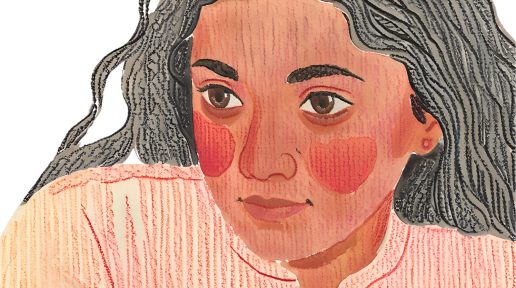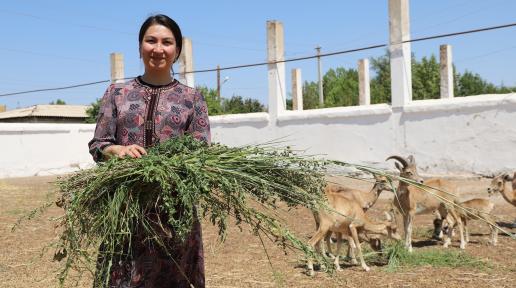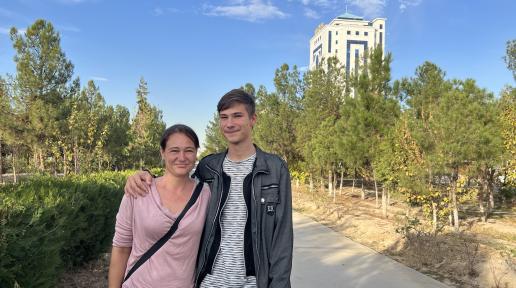Waka
23 dekabr 2025
Aýsoltan Annamämmedowa: Sanly tehnologiýalardaky Türkmenistanyň ýaş zehini
Tehnologiýa we innowasiýalara hemişe höwesli bolan Oguz Han adyndaky Inženerçilik we Tehnologiýa Uniwersitetiniň dördünji ýyl talyby Aýsoltan Annamämmedowa ýakynda Türkiýäniň Stambul şäherinde geçirilen "Gelejekki başarnyklar sprinti" halkara bilim başlangyjyna gatnaşmak bilen geljege batyrgaý ädim ätdi. Bu intensiw maksatnama zehinli ýaşlaryň arasynda sanly başarnyklary, innowasion pikirlenişi we hünär başarnyklaryny ösdürmäge gönükdirilendir.MEXT Tehnologiýa Merkezi tarapyndan Stambuldaky BMGÖM Sebit Merkezi (UNDP IRH), BMGÖM Türkiýe we Türkiýäniň "Hepsiburada" tehnologiýa kompaniýasy bilen hyzmatdaşlykda guralan bu başlangyç 2025-nji ýylyň 20-22-nji noýabry aralygynda dünýäniň dürli künjeginden ýaş hünärmenleri emeli intellektiň, sanly ykdysadyýetiň we global zähmet bazarynyň meýillerini öwrenmek üçin bir ýere jemledi.Aýsoltan BMGÖM IRH tarapyndan hödürlenýän alty hepdelik onlaýn okuwlary tamamlandan soň, şahsy maksatnama gatnaşmak hukugyny gazandy. Bu taýýarlyk sapaklarynda halkara bilermenler gatnaşyjylary awtomatlaşdyrma, emeli intellekt, durnuklylyk, üpjünçilik zynjyrlary we global tehnologiýa meýilleri ýaly mowzuklar bilen tanyşdyrdylar. Kurslar onuň hyzmatdaşlygyny we meseleleri çözmek başarnyklaryny güýçlendirdi we sanly innowasiýalarda täze mümkinçilikleri öwrenmäge ylham berdi."Geljekki başarnyklar sprinti meniň üçin täze mümkinçilikler dünýäsini açdy" diýip, Aýsoltan aýtdy. "Bu maňa öňe gitmäge, öwrenmäge we geljegimi kemala getirmäge ynam berdi."Stambulda üç günlük kursda Aýsoltan öňdebaryjy tehnologiýalar bilen işlemekde özboluşly tejribe toplady. Maksatnamanyň esasy pursatlary Senagat 4.0 tehnologiýalaryny görkezýän Sanly Fabrika gezelenji, ÝB ETS we CBAM barada leksiýalar we tehnologik çözgütleri Durnukly Ösüş Maksatlary (DÖM) bilen baglanyşdyrýan ussatlyk sapaklary boldy. Dersler diňe bir onuň tehniki bilimlerini çuňlaşdyrman, eýsem onuň döredijiligini, tankydy pikirlenişini we toparlaýyn iş başarnyklaryny ösdürdi - bularyň hemmesi çalt üýtgeýän sanly dünýäde zerurdyr.Geljekki Iş Akademiýasy bilen Tehniki başarnyklary ösdürmekAýsoltanyň Geljekki başarnyklar sprintine gatnaşmagy BMGÖM-niň Stambuldaky Sebit Merkezi tarapyndan amala aşyrylýan giň sebitleýin Geljekki Iş Akademiýasy taslamasynyň bir bölegidir. Bu başlangyç Ýewropada we Merkezi Aziýada ýaşlary ýaşyl we sanly geçişe üstünlikli gatnaşmak üçin zerur bolan başarnyklar bilen üpjün etmäge gönükdirilendir. Sprint Akademiýanyň intensiw ýüzbe-ýüz moduly bolup hyzmat edýär we emeli intellekt, senagat 4.0 tehnologiýalary, durnukly ösüş we geljekki başarnyklar bilen tejribe hödürleýär.Aýsoltan alty hepdelik onlaýn kurslary tamamlap we Stambulda ýüzbe-ýüz Geljekki başarnyklar Sprint bilim başlangyjyna gatnaşyp, bu sebitleýin ekoulgam çemeleşmesiniň bir bölegine öwrüldi we amaly we geljege laýyk başarnyklary gazandy. Bu maksatnama onuň yzygiderli üýtgeýän zähmet bazarynda ösmegini güýçlendirdi we has uly taslamalary amala aşyrmaga ylham berdi.Türkiýeden, Özbegistandan, Täjigistandan, Gazagystandan we Gyrgyzystandan gelen kärdeşleri bilen aragatnaşyk saklamak onuň hünär dünýägaraýşyny giňeltdi. Dürli ýurtlardan gelen ýaş hünärmenler bilen pikir alyşmak we hyzmatdaşlyk etmek onuň tejribesini baýlaşdyrdy."Geljekki başarnyklar Sprinti maňa öwrenmegi, synanyşmagy we mümkinçilikleri ulanmaga dowam etmäge ynam berdi" diýip, Aýsoltan paýlaşýar. "Her täze başarnyk innowasiýalara ýol açýar we meniň hünär ýolumy kemala getirýär." Geljekki başarnyklar akademiýasy bilen öwrenmek we ösdürmekAýsoltan Stambulda gatnaşmakdan başga-da, BMGÖM-niň Geljekki başarnyklar akademiýasy arkaly başarnyklaryny ösdürmegini dowam etdirýär. 2025-nji ýylyň awgust aýynda Ýaponiýanyň hökümeti tarapyndan maliýeleşdirilýän we BMGÖMtarapyndan Türkmenistanyň Zähmet we ilatyň durmuş taýdan goramak ministrligi bilen hyzmatdaşlykda amala aşyrylýan "Merkezi Aziýada zorlukly ekstremizmiň öňüni almak üçin durnukly jemgyýetleri ösdürmek" sebitleýin taslamasynyň Türkmenistanyň ýurt bölegi hökmünde başlanan bu dinamiki başlangyç, ýurduň ähli ýerlerinden ýaşlara häzirki zaman zähmet bazary üçin isleg bildirilýän başarnyklara gönükdirilen Coursera platformasyndaky ýokary hilli onlaýn kurslara elýeterliligi üpjün edýär. Aýsoltan häzirki wagtda IBM AI Inženerçilik kursuny, şeýle hem sanly sowatlylyk, programmirleme we hünär ösüşi boýunça programmalary alýar. Bu giňişleýin bilim syýahaty arkaly Aýsoltan diňe bir sanly başarnyklaryny kämilleşdirmän we döredijilik pikirlenişini ösdürmän, eýsem toparlara ýolbaşçylyk edip we möhüm taslamalary durmuşa geçirip bilýän ýokary hünärli web işläp düzüjisi bolmaga taýýarlanýar. "Gelejekki başarnyklar akademiýasy" we "Gelejekki başarnyklar sprinti" tejribesiniň bir bölegi hökmünde ol biolukmançylyk elektronikasyna ünsi jemläp, kiber-fiziki ulgamlary öwrenýär we çalt üýtgeýän sanly giňişlikde uly möçberli taslamalary durmuşa geçirmek we karýera ösüşi boýunça uzak möhletli maksadyny goldaýan IBM AI Inženerçilik kursuny alýar.Ilkinji "Gelejekki başarnyklar akademiýasy" maksatnamasy eýýäm öz netijeliligini subut etdi: 1000-den gowrak ýaşlar we zenan birinji topary tamamlady. Ikinji tapgyr Aýsoltan ýaly ýaş gatnaşyjylary goldamagy dowam etdirýär, olaryň işe ýerleşmek ukybyny, durnuklylygyny we jemgyýete işjeň gatnaşmagyny artdyrýar. Aýsoltanyň maksatlaryna ygrarlylygy diňe bir şahsy maksatlaryny däl, eýsem, Türkmenistanyň ýaşlarynyň tehnologik innowasiýalary ösdürmek we jemgyýetçilik ösüşine goşant goşmak mümkinçiliklerini hem görkezýär."Öwrenýän her täze başarnygym maňa täze zatlary synap görmek üçin has köp ynam berýär. Men kynçylyklary kabul etmäge, pikirleri öwrenmäge we bilimlerimi hakyky üýtgeşmeleri döretmek üçin ulanmaga taýýar."Aýsoltanyň ýoly ýaşlar tarapyndan ýolbaşçylyk edilýän innowasiýa başlangyçlarynyň özgerdiji güýjüni görkezýär. BMGÖM "Gelejekki başarnyklar Sprinti" we "Gelejekki başarnyklar akademiýasy" ýaly maksatnamalar arkaly dünýäniň dürli künjegindäki ýaşlara sanly deňsizligi aradan aýyrmaga, isleg bildirilýän başarnyklary ele almaga we durnukly we inkluziw ösüşe goşant goşmaga kömek edýär. Onuň hekaýasy şu günki ýaşlara maýa goýmagyň geljegiň çylşyrymly kynçylyklaryna çözgüt tapmaga ukyply liderleri, innowatorlary we hünärmenleri döretjekdigini görkezýär.









